|
Why is Monitoring Vibration Important?
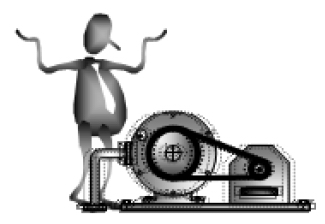
• Monitoring machine vibration and using the information you obtain saves money!
• How is this possible?
• We will answer this question in the following pages.
After reading this article you wil :
• Understand the term 'machine vibration'
• Cite some common causes of machine vibration
• Explain the reasons for monitoring machine vibration
• Understand how monitoring machine vibration saves money
What is Machine Vibration?
Most of us are familiar with vibration; a vibrating object moves to and fro, back and forth. A vibrating object oscillates.
We experience many examples of vibration in our daily lives. A pendulum set in motion vibrates. A plucked guitar string vibrates. Vehicles driven on rough terrain vibrate, and geological activity can cause massive vibrations in the form of earthquakes.
There are various ways we can tell that something is vibrating. We can touch a vibrating object and feel the vibration. We may also see the back-and-forth movement of a vibrating object. Sometimes vibration creates sounds that we can hear or heat that we can sense. To observe how vibration can create sound and heat, rub your feet back and forth on a carpet.
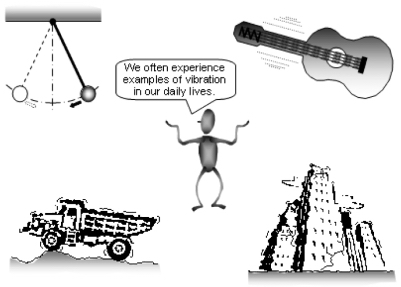
In industrial plants there is the kind of vibration we are concerned about: machine vibration.
What is machine vibration? Machine vibration is simply the back and forth movement of machines or machine components. Any component that moves back and forth or oscillates is vibrating.
Machine vibration can take various forms. A machine component may vibrate over large or small distances, quickly or slowly, and with or without perceptible sound or heat. Machine vibration can often be intentionally designed and so have a functional purpose. (Not all kinds of machine vibration are undesirable. For example, vibratory feeders, conveyors, hoppers, sieves, surface finishers and compactors are often used in industry.)
At other times machine vibration can be unintended and lead to machine damage. Most times machine vibration is unintended and undesirable. This article is about the monitoring of undesirable machine vibration.
Shown below are some examples of undesirable machine vibration.
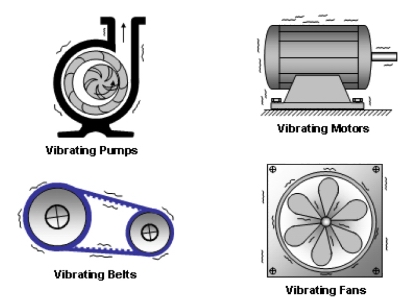
What is Machine Vibration?
Almost all machine vibration is due to one or more of these causes:
(a) Repeating forces
(b) Looseness
(c) Resonance
(a) Repeating Forces
Imagine a boat anchored in a bay. Waves are slapping the sides of the boat, and as long as the waves continue to act on the boat we would expect the boat to rock.
The boat would be rocking because the waves would be exerting a repeating force on the boat - a force of a pattern repeated over and over again.
Most machine vibration is due to repeating forces similar to those causing the boat to rock. Repeating forces such as these act on machine components and cause the machine to vibrate. Where do the repeating forces that cause machine vibration come from?
Repeating forces in machines are mostly due to the rotation of imbalanced, misaligned, worn, or improperly driven machine components. Examples of these four types of repeating forces are shown below.
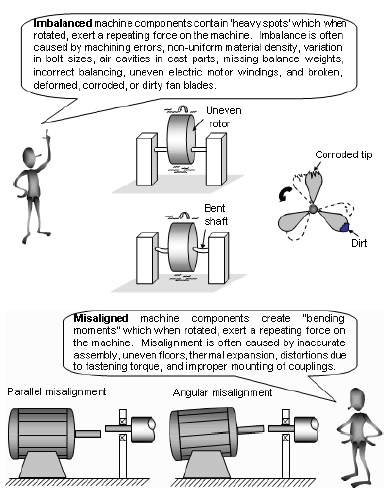
(b) Looseness
Looseness of machine parts causes a machine to vibrate. If parts become loose, vibration that is normally of tolerable levels may become unrestrained and excessive.
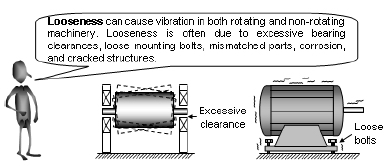
(c) Looseness
Imagine a child swinging freely on a swing, that is, without the child propelling himself or anyone pushing him. If we observe the motion closely we will see the child swinging at a particular rate. For example, we may see that it consistently takes him three seconds to complete one cycle of swinging.
The rate of the child's free-swinging is in fact a physical property of the child-swing system - much as the weight of the child is a physical property of the child. It is the rate at which the child will tend to swing while seated on that particular swing. It is the child's most natural swinging rate on the swing, and the only way he can change it is to interfere with the natural swinging by propelling himself with his feet, changing his posture, rubbing his feet on the ground and so on.
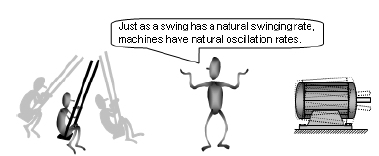
Machines also tend to vibrate at certain oscillation rates. The oscillation rate at which a machine tends to vibrate is called its natural oscillation rate. The natural oscillation rate of a machine is the vibration rate most natural to the machine, that is, the rate at which the machine 'prefers' to vibrate.
A machine left to vibrate freely will tend to vibrate at its natural oscillation rate. Most machines have more than one natural oscillation rate. For example, a machine comprising two substructures of different natural oscillation rates will exhibit at least two natural oscillation rates. In general, the more complex the machine, the more natural oscillation rates it has.
Now consider again the child on the swing. If we aided the swinging motion by repeatedly pushing the child, we would expect the child to swing higher and higher over time.

We would however only cause the child to swing higher and higher if we pushed with the right rhythm. If our pushing rhythm is such that he is sometimes pushed down while he is ascending, we would not expect him to swing properly. To make him swing higher and higher, our pushing rhythm would in fact need to be in harmony with his natural oscillation rate.
For example, we could push him every time - or every alternate time - he reaches his highest point. Only by pushing the child at a rate which is in harmony with his natural or preferred oscillation rate can we cause him to quickly swing higher and higher.
What happens if a machine is 'pushed' by a repeating force with a rhythm matching the natural oscillation rate of the machine? A similar situation will arise - the machine will vibrate more and more strongly due to the repeating force encouraging the machine to vibrate at a rate it is most natural with. The machine will vibrate vigorously and excessively, not only because it is doing so at a rate it 'prefers' but also because it is receiving external aid to do so. A machine vibrating in such a manner is said to be experiencing resonance.
A repeating force causing resonance may be small and may originate from the motion of a good machine component. Such a mild repeating force would not be a problem until it begins to cause resonance. Resonance, however, should always be avoided as it causes rapid and severe damage. For example, whole bridges have collapsed due to their natural oscillation rates being excited by the mere rhythm of soldiers marching in unison across the bridges.
VIBRATION PRODUCTS :
|








